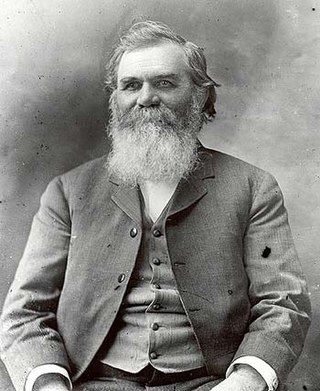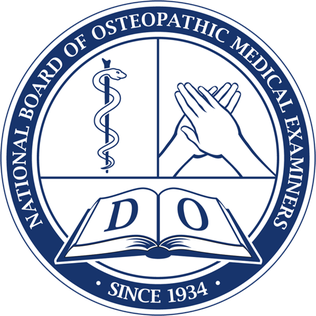Related Research Articles

Chiropractic is a form of alternative medicine concerned with the diagnosis, treatment and prevention of mechanical disorders of the musculoskeletal system, especially of the spine. It has esoteric origins and is based on several pseudoscientific ideas.

A physician, medical practitioner, medical doctor, or simply doctor is a health professional who practices medicine, which is concerned with promoting, maintaining or restoring health through the study, diagnosis, prognosis and treatment of disease, injury, and other physical and mental impairments. Physicians may focus their practice on certain disease categories, types of patients, and methods of treatment—known as specialities—or they may assume responsibility for the provision of continuing and comprehensive medical care to individuals, families, and communities—known as general practice. Medical practice properly requires both a detailed knowledge of the academic disciplines, such as anatomy and physiology, underlying diseases and their treatment—the science of medicine—and also a decent competence in its applied practice—the art or craft of medicine.

Osteopathy, unlike Osteopathic medicine, is a pseudoscientific system of alternative medicine that emphasizes physical manipulation of the body's muscle tissue and bones. In most countries, practitioners of osteopathy are not medically trained and are referred to as osteopaths.

A podiatrist is a medical professional devoted to the treatment of disorders of the foot, ankle, and related structures of the leg. The term originated in North America but has now become the accepted term in the English-speaking world for all practitioners of podiatric medicine. The word chiropodist was previously used in the United States, but it is now regarded as antiquated.

A medical license is an occupational license that permits a person to legally practice medicine. In most countries, a person must have a medical license bestowed either by a specified government-approved professional association or a government agency before they can practice medicine. Licenses are not granted automatically to all people with medical degrees. A medical school graduate must receive a license to practice medicine to legally be called a physician. The process typically requires testing by a medical board. The medical license is the documentation of authority to practice medicine within a certain locality. An active license is also required to practice medicine as an assistant physician, a physician assistant or a clinical officer in jurisdictions with authorizing legislation.

Podiatry, or podiatric medicine and surgery, is a branch of medicine devoted to the study, diagnosis, and treatment of disorders of the foot, ankle and lower limb. The healthcare professional is known as a podiatrist. The US podiatric medical school curriculum includes lower extremity anatomy, general human anatomy, physiology, general medicine, physical assessment, biochemistry, neurobiology, pathophysiology, genetics and embryology, microbiology, histology, pharmacology, women's health, physical rehabilitation, sports medicine, research, ethics and jurisprudence, biomechanics, general principles of orthopedic surgery, plastic surgery, and foot and ankle surgery.

Midwestern University (MWU) is a private medical and professional school with campuses in Downers Grove, Illinois and Glendale, Arizona. As of the 2022–23 academic year, a total of 2,758 students were enrolled at the Downers Grove campus and 3,782 were enrolled at the Glendale campus.
The United States Medical Licensing Examination (USMLE) is a three-step examination program for medical licensure in the United States sponsored by the Federation of State Medical Boards (FSMB) and the National Board of Medical Examiners (NBME). Physicians with a Doctor of Medicine (MD) degree are required to pass the USMLE for medical licensure. However, those with a Doctor of Osteopathic Medicine degree (DO) are required to take the COMLEX-USA (COMLEX) exams.
A medical degree is a professional degree admitted to those who have passed coursework in the fields of medicine and/or surgery from an accredited medical school. Obtaining a degree in medicine allows for the recipient to continue on into specialty training with the end goal of securing a license to practice within their respective jurisdiction. Medical graduates may also pursue non-clinical careers including those in basic research and positions within the healthcare industry. A worldwide study conducted in 2011 indicated on average: 64 university exams, 130 series exams, and 174 assignments are completed over the course of 5.5 years. As a baseline, students need greater than an 85% in prerequisite courses to enrol for the aptitude test in these degree programs.

Des Moines University (DMU) is a private medical school in West Des Moines, Iowa. Founded in 1898, Des Moines University is the second oldest osteopathic medical school and the fifteenth largest medical school in the United States. DMU's three colleges—the College of Osteopathic Medicine, College of Podiatric Medicine and Surgery, and College of Health Sciences—offer nine academic degrees, including master's and doctorate degrees.

The American Osteopathic Association (AOA) is the representative member organization for the more than 176,000 osteopathic medical doctors (D.O.s) and osteopathic medical students in the United States. The AOA is headquartered in Chicago, Illinois, and is involved in post-graduate training for osteopathic physicians. Beginning in 2015, it began accrediting post-graduate education as a committee within the Accreditation Council for Graduate Medical Education, creating a unified accreditation system for all DOs and MDs in the United States. The organization promotes public health, encourages academic scientific research, serves as the primary certifying body for D.O.s overseeing 18 certifying boards, and is the accrediting agency for osteopathic medical schools through its Commission on Osteopathic College Accreditation. As of October 2015, the AOA no longer owns the Healthcare Facilities Accreditation Program (HFAP), which accredited hospitals and other health care facilities.
Podiatric Medical School is the term used to designate the institutions which educate students and train them to be podiatrists, which diagnose and treat conditions affecting the foot, ankle, and related structures of the leg. In the United States, only schools which are accredited by the Council on Podiatric Medical Education (CPME) may earn the status of being a Podiatric Medical School. The Doctor of Podiatric Medicine degree is commonly abbreviated D.P.M. degree. The D.P.M. degree is a prerequisite for an individual to be accepted into a CPME accredited residency. The preparatory education of most podiatric physicians — similar to the paths of traditional physicians — includes four years of undergraduate work, followed by four years in an accredited podiatric medical school, followed by a three- or four-year hospital-based podiatry residency. Optional one- to two-year fellowship in foot and ankle reconstruction, surgical limb salvage, sports medicine, plastic surgery, pediatric foot and ankle surgery, and wound care is also available.
A medical specialty is a branch of medical practice that is focused on a defined group of patients, diseases, skills, or philosophy. Examples include those branches of medicine that deal exclusively with children (paediatrics), cancer (oncology), laboratory medicine (pathology), or primary care. After completing medical school or other basic training, physicians or surgeons and other clinicians usually further their medical education in a specific specialty of medicine by completing a multiple-year residency to become a specialist.

The history of chiropractic began in 1895 when Daniel David Palmer of Iowa performed the first chiropractic adjustment on a partially deaf janitor, Harvey Lillard.While Lillard was working without his shirt on in Palmer's office, Lillard bent over to empty the trash can. Palmer noticed that Lillard had a vertebra out of position. He asked Lillard what happened, and Lillard replied, "I moved the wrong way, and I heard a 'pop' in my back, and that's when I lost my hearing." Palmer, who was also involved in many other natural healing philosophies, had Lillard lie face down on the floor and proceeded with the adjustment. The next day, Lillard told Palmer, "I can hear that rackets on the streets." This experience led Palmer to open a school of chiropractic two years later. Rev. Samuel H. Weed coined the word "chiropractic" by combining the Greek words cheiro (hand) and praktikos.
Doctor of Osteopathic Medicine is a medical degree conferred by the 38 osteopathic medical schools in the United States. DO and Doctor of Medicine (MD) degrees are equivalent: a DO graduate may become licensed as a physician or surgeon and thus have full medical and surgical practicing rights in all 50 US states. As of 2021, there were 168,701 osteopathic physicians and medical students in DO programs across the United States. Osteopathic medicine emerged historically from osteopathy, but has become a distinct profession.
The Federation of State Medical Boards (FSMB) of the United States is a national non-profit organization that represents the 71 state medical and osteopathic boards of the United States and its territories and co-sponsors the United States Medical Licensing Examination. Medical boards license physicians, investigate complaints, discipline those who violate the law, conduct physician evaluations, and facilitate the rehabilitation of physicians where appropriate. The FSMB's mission calls for "continual improvement in the quality, safety and integrity of health care through the development and promotion of high standards for physician licensure and practice."
Osteomyology is a multi-disciplined form of alternative medicine found almost exclusively in the United Kingdom and is loosely based on aggregated ideas from other manipulation therapies, principally chiropractic and osteopathy. It is a results-based physical therapy tailored specifically to the needs of the individual patient. Osteomyologists have been trained in osteopathy and chiropractic, but do not require to be regulated by the General Osteopathic Council (GOsC) or the General Chiropractic Council (GCC).

Health professional requisites refer to the regulations used by countries to control the quality of health workers practicing in their jurisdictions and to control the size of the health labour market. They include licensure, certification and proof of minimum training for regulated health professions.

The National Board of Osteopathic Medical Examiners (NBOME), founded in 1934 as the National Osteopathic Board of Examiners for Osteopathic Physicians and Surgeons, Inc., is a United States examination board which sets state recognized examinations for osteopathic medical students and began administering exams in February 1935. The NBOME is an independent, nonprofit organization and is headquartered in Chicago, Illinois and Conshohocken, Pennsylvania. The NBOME states that its mission is "to protect the public by providing the means to assess competencies for osteopathic medicine and related health care professions." The NBOME conducts research to monitor the quality of the COMLEX examinations.
Various organizations of practicing chiropractors have outlined formal codes of professional ethics. Actual practice has revealed a wide range of behaviors which may or may not conform to these standards.
References
- ↑ "Contact a State Medical Board". Federation of State Medical Boards . Archived from the original on 2022-09-24. Retrieved 2022-09-24.
- ↑ An Act regulating the practice of medicine, surgery and obstetrics, providing for the issuing of licenses to practice, providing for the appointment of a State Board of Medical Registration and Examination and defining their duties, defining certain misdemeanors and providing penalties, and repealing all laws in conflict therewith and certain acts therein specified, H. 226, Indiana General Assembly, March 8, 1897.
- ↑ First Annual Report of the State Board of Medical Registration and Examination. State Board of Health. 1898. pp. 407–500. Retrieved August 5, 2022.
- 1 2 3 4 5 6 7 "About the Medical Licensing Board". Indiana Professional Licensing Agencies. State of Indiana. January 21, 2021. Retrieved August 5, 2022.
- ↑ "Indiana Board of Chiropractic Examiners". Indiana Professional Licensing Agencies. State of Indiana. Retrieved August 5, 2022.
- ↑ "Indiana Podiatric Medicine Board". Indiana Professional Licensing Agencies. State of Indiana. Retrieved August 5, 2022.
- ↑ Indiana Code § 25-22.5-2-1 (2021), Creation of Medical Licensing Board; Creation and Membership
- ↑ "Limited Scope Temporary Medical Permit". Indiana Professional Licensing Agencies. State of Indiana. Retrieved August 5, 2022.
- ↑ "Health Care Volunteer Registry". Indiana Professional Licensing Agencies. State of Indiana. Retrieved August 5, 2022.
- ↑ Indiana Code, Article 22.5 (2021), Physicians
- ↑ Indiana Administrative Code, Title 844 (2021), Medical Licensing Board